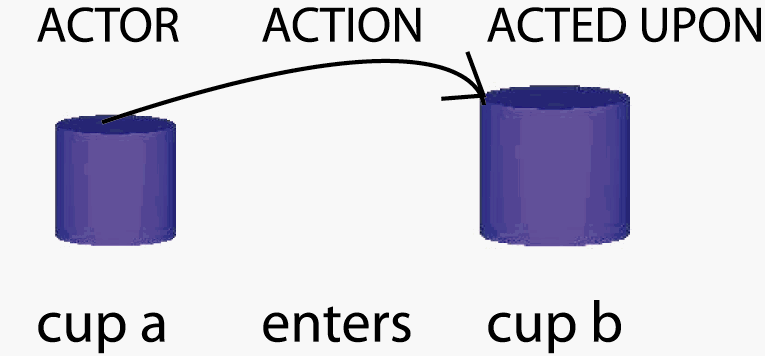The seriate nesting cups framework
Coneural > Ioana Goga > PhD
research > The seriate nesting cups framework
Greenfield et al. (1972) experiment
Our computational framework is built upon the seriate nesting
cups experiment of Greenfield and colleagues (1972). Greenfield and colleagues
reported at children between 11 and 36 months of age, the presence of three
distinct strategies for combining cups of different sizes (see bellow). They
stressed the homology between the action strategies employed and specific grammatical
constructions. When a cup "acts upon" another cup to form a new structure,
there is a relation of actor-action-acted upon; such a relation is realized
in sentence structures like subject-verb-object.
a) The pairing method, when a single cup is placed in/on a second cup.
This action strategy would correspond to the use of simple two-words sentence.

Figure 2a. Formal correspondence between pairing manipulation strategy and
sentence type (as described by Greenfield et al. 1972).
b) The pot method, when two or more cups are placed in/on another cup.
This strategy allow the conjunction of multiple actor-action-acted upon sequences.

Figure 2b. Formal correspondence between pot manipulation strategy and sentence
type.
c) The sub-assembly method, when a previously constructed structure
consisting of two or more cups is moved as a unit in/on another cup or cup structure.
The embedding of the cups is accomplished, reflected into the capacity of using
relative clauses in the language.

Figure 2c. Formal correspondence between sub-assembly manipulation strategy
and sentence type.
The choice of the acting/acted upon cups is made using three possible criteria:
size, proximity and contiguity. Youngest children typically use the proximity
criteria (i.e., same side of the table with the moving hand) for pairing cups.
Among the 16-24-month-old, the contiguity alone (i.e., never reach behind a
nearer cup to use a more distant cup) is the criterion for the pot strategy.
For the 28- to 36-moth-old, size alone is used as the criteria to combine cups.
While young children operate as though size is a binary concept (i.e., one cup
treated as the "biggest" and all the others as "little"),
by 36 month of age, children develop a systematic strategy of seriation.
See here a computational model of the
first two developmental stages of seriate nesting cups behavior.
Psychological relevance of the experimental framework
The ability to seriate objects, based on the capacity to relate an intermediate
element both backwards to the previous element and forwards to the next element
in
the sequence, has posed many interesting questions for cognitive scientists.
Greenfield et al. (1972) suggested that success at seriation reflects the child's
growing recognition of a reversible relationship. Based on a series of experiments
with children, apes and monkeys, Johnson-Pynn et al. (2000) argue that the development
of skill in seriation is experientially, rather than conceptually driven, and
that it may be unnecessary to link skill at seriation with cognitive conceptions
of reversibility or linguistic capacities.
Greenfield (1991) adduced evidence from neurology, neuropsychology, and animal
studies to support the view that object combination and speech production are
are built upon an initially common neurological foundation, which then divides
into separate specialized areas as development progresses. The hypothesis proposed
by her, is that early in a child’s development Broca’s region may
serve the dual function of coordinating object assembly and organizing the production
of structured utterances. Reilly (1997) brought computational evidence to this
hypothesis, and developed the theory of 'cortical software re-use' as a means
for incremental development of higher cognitive functions on the foundation
of low-level sensori-motor primitives.
The seriate nesting cups experiment is also of relevance to the theory of goal-directed
imitation, proposed by Bekkering et al.(2000), to account for the developmental
differences in infants imitation behavior. The study suggests that during demonstration
younger children form a generalized goal of the form <keep
putting cups inside each other>, while the older children use the
goals also as a basis for terminating activity. The seriate cups task can be
used, for instance, to investigate how to discover what to imitate from
a demonstrated task
We believe that the seriate nesting cups task represents a promising framework
for the exploration of the interplay between imitative, manipulatory and linguistic
skills development.
Relevant papers
Bekkering, H., Wohlschlager, A., Gattis, M. (2000). Imitation is goal-directed.
Quarterly Journal of Exp. Psychology, 153-64.
Greenfield, P., Nelson, K., Saltzman, E. (1972). The development of rulebound
strategies for manipulating seriated cups: a parallel between action and grammar.
Greenfield, P. (1991). Language, tool and brain: The ontogeny and phylogeny
of hierarchically organized sequential behavior. Behavioral and Brain Sciences,
14,
531-595.
Johnson-Pynn, J.S., Fragaszy, D., Brakke, K., Galloway, A. (2000). The sources
of skill in seriating nesting cups in children, apes, and monkeys.
Reilly, R.G. (in press). The relationship between object manipulation and language
development in broca’s area: a connectionist simulation of Greenfield’s
hypothesis. Behavioral and Brain Sciences.
|

